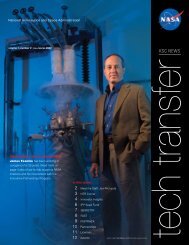2006-2007 - Kennedy Space Center Technology Transfer Office
2006-2007 - Kennedy Space Center Technology Transfer Office
2006-2007 - Kennedy Space Center Technology Transfer Office
- No tags were found...
Create successful ePaper yourself
Turn your PDF publications into a flip-book with our unique Google optimized e-Paper software.
Measuring Ultrasonic Acoustic Velocity in a Thin Sheet of Graphite EpoxyCompositeA method for measuring the acoustic velocity in a thin sheet of a graphite epoxy<strong>Space</strong>port/RangeSituational composite (GEC) material was investigated. This method uses two identical acousticemission(AE) sensors, one to transmit and one to receive. The delay time as a functionAwarenessof distance between sensors determines a bulk velocity. A lightweight fixture (balsawood in the current implementation) provides a consistent method of positioning the sensors, thusproviding multiple measurements of the time delay between sensors at different known distances. Alinear fit to separation, x, versus delay time, t, will yield an estimate of the velocity from the slope ofthe line.Figure 1 shows the test jig used to align the AE transducers for the velocity measurements. Thetransmitting and receiving sensors are identical. The transducer on the left is the excitationtransducer (transmitter) and the transducer on the right is the receiver. Both transducers are modelWD wideband AE sensors manufactured by Physical Acoustics Corporation. A small amount ofvacuum grease couples the AE sensors to the GEC surface. Removing the jig before a measurementis recorded minimizes the effect of test fixture loading and coupling. After each set of measurements,the grease is removed with an industrial wipe soaked in isopropyl alcohol.The excitation signal is generated from a 5-V, peak-to-peak, 360-kHz, sinusoidal pulse composedof eight full cycles. The oscilloscope top trace, on the left of Figure 2, shows the transmitted signaland a typical received signal on the bottom. Pulse data for six distances (2, 4, 6, 8, 10, and 12 cm) isrecorded, with the oscilloscope sampling average set to eight sweeps in order to remove the majorityof the random noise from the AE sensor signal. Figure 3 shows an example of all received pulses fortwo sets of runs of a GEC sample material. When the delay times, as a function of ∆x are plotted(shown in Figure 4), a linear fit yields an estimate of the acoustic velocity as the slope of the curve.Contacts: Dr. John E. Lane , ASRC Aerospace, (321) 867-6939; and Stanley O. Starr, NASA-KSC, (321) 861-2262Figure 1. Ultrasonic Acoustic-Velocity Test: 6-cm separation (left); 10-cm separation (right). Topshows alignment with jig; bottom is signal measurement configuration.48 <strong>Space</strong>port Structures and Materials













